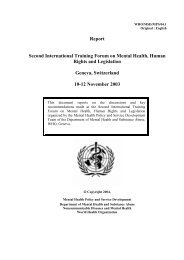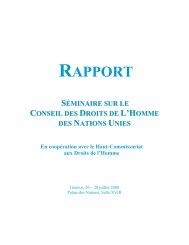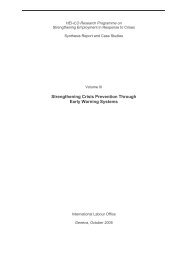Volume 1 Cedric - revised luca Final - RUIG-GIAN
Volume 1 Cedric - revised luca Final - RUIG-GIAN
Volume 1 Cedric - revised luca Final - RUIG-GIAN
Create successful ePaper yourself
Turn your PDF publications into a flip-book with our unique Google optimized e-Paper software.
6. Small entrepreneur strategies in Iraq: Afocus on women6.1. Assessing female participation in the private sector6.1.1. A focus on the industrial sectorWomen have seen themselves limited to only a few sectors of economic activity inIraq, notably in the textile and leatherwear, food and chemical industries. According to a1983 study, female participation rates accounted for 42, 26 and 8 per cent respectively ofthe total work force in these sectors. Most women are semi-skilled workers (51 per cent),while 28 per cent are skilled. In the late 1970s, the mainstream of private industry in Iraqshifted in focus to metal industries, chemicals, chinaware, woodworking, and construction,replacing the precedence of food industries, textile and leatherwear that prevailed untilthen. Clearly, therefore, those industries where women predominated in private enterpriseshave lost ground.Trends illustrate that female entrepreneurship is limited to a large extent to the sectorswhere high numbers of women are employed. Women have established and/or ownedindustrial enterprises in a limited number of fieldsm mainly in the production of pasta,cosmetics, perfumes, and shampoo (by trademark franchising), as well as knittingworkshops and a few similar businesses.Statistics from the Iraqi Union of Industries for 2000/2004, as presented in thefollowing tables, show, however, that enterprises registered by women barely representmore than 1 per cent of the current enterprises (230 out of 21,798). One-hundred-fifty-fiveof these are located in Baghdad. 84 Textile industries come first in the list of enterprisesregistered as industries, followed by metal and food industries; these total about 73 percent of women’s enterprises. Construction and chemicals come next.Data on enterprises under construction, which are interesting since they reflects post-2003 trends, shows that enterprises registered by women total 916 out of 11,258. Industriesaccounted for 8 per cent of these. Textile industries still lead in numbers, counting as manyas 386, followed by metal industries (204), and manufacturing (178). They make up 84 percent of total projects (tallying 768 out of 916). A large number of industries are registeredin Baghdad (390 or 43 per cent of the total). It should still be noted that there are a fewwomen entrepreneurs in almost all industrial branches, with women participating in asmany as 124 types of small enterprises.84 Most enterprises are registered in the central governorates, then Northern and Southern governorates. Thiscould be accounted for by the distances, which divide the headquarters of the Union of Industries and itsmembers. It should be noted that not all current industries are registered in the Union of Industries sinceregistration is voluntary on a need basis, especially for small industries.71














